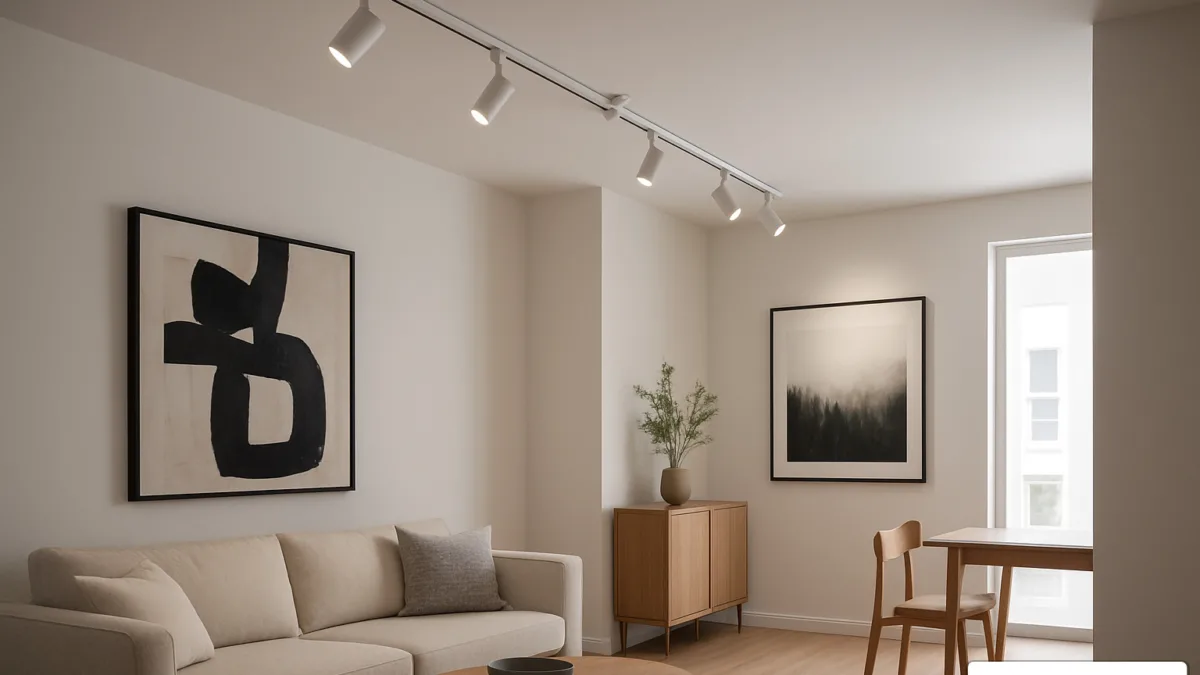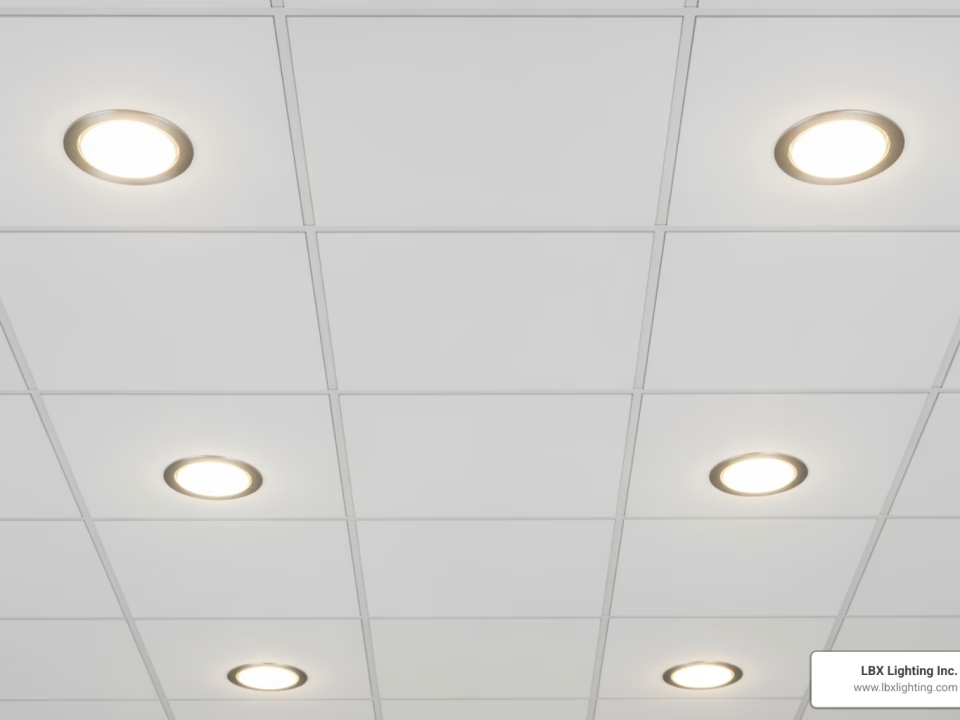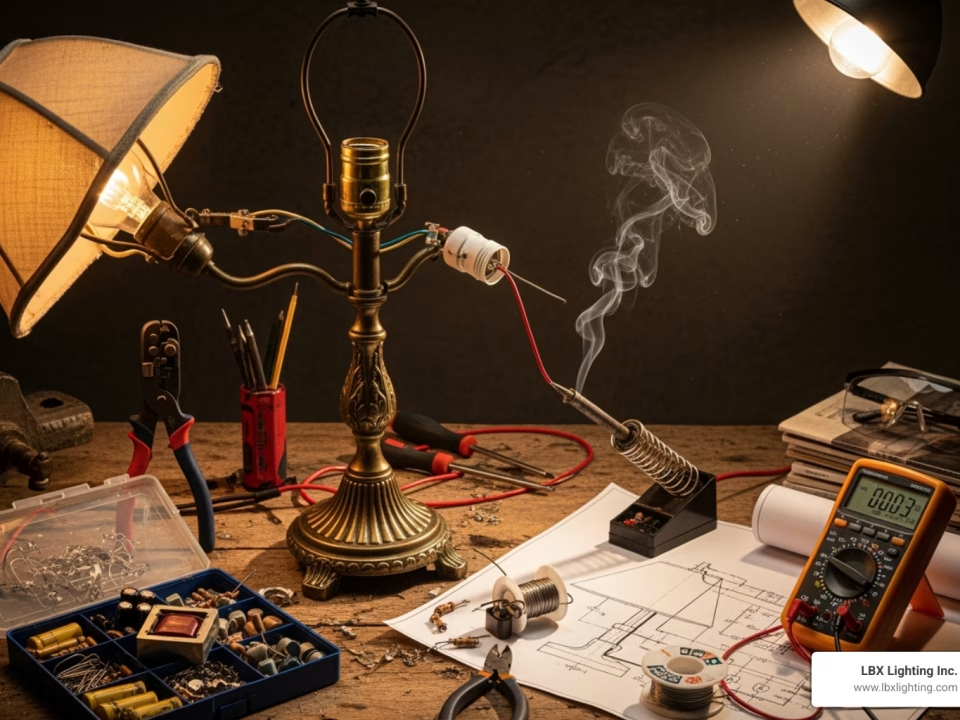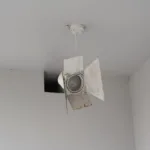
Bright Idea or Fan Fail? Master Ceiling Fan Light Installation Yourself
July 2, 2025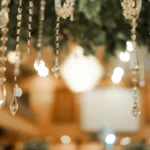
Where to Find Stunning Chandeliers in Houston Without Breaking a Sweat
July 4, 2025Why Adjustable LED Track Lighting is Changing Modern Spaces
Adjustable LED track lighting offers the perfect blend of flexibility, energy efficiency, and style for any space. These versatile systems can reduce energy consumption by up to 80% compared to traditional incandescent lighting while delivering up to 2,450 lumens of focused illumination exactly where you need it.
Key Benefits of Adjustable LED Track Lighting:
- Energy Efficient: 80% less energy consumption than traditional bulbs
- Long-Lasting: 30,000+ hour lifespan reduces maintenance costs
- Flexible Design: 350° rotation and 90° tilt for precise light positioning
- Multiple Applications: Perfect for kitchens, galleries, retail spaces, and offices
- Smart Integration: Compatible with dimmers and smart home systems
- Cost-Effective: Quality kits available from $50-$150
Whether you’re highlighting artwork in a gallery, providing task lighting over a kitchen island, or creating ambient lighting in a living room, adjustable LED track lighting delivers professional results. The ability to direct light exactly where needed makes these systems ideal for both residential and commercial applications.
As someone who has spent over 30 years helping Houston area clients find the perfect lighting solutions, I’ve seen how adjustable LED track lighting transforms spaces while delivering exceptional value and performance. At LBX Lighting, we’ve guided countless interior designers and homeowners through selecting and installing these versatile systems that truly make spaces shine.
Understanding Adjustable LED Track Lighting
Picture this: you’re in your kitchen, and you need bright task lighting over your island for meal prep, but softer ambient lighting for dinner with friends. With adjustable LED track lighting, you can have both from the same system.
At its heart, adjustable LED track lighting is beautifully simple. You have a continuous rail system that carries electricity, and moveable light fixtures that slide along and connect anywhere on that rail. Think of it as a power strip for your ceiling, but infinitely more neat and functional.
The conductive track rail does double duty as both electrical conductor and mechanical support. Your adjustable light heads can rotate, tilt, and reposition to put light exactly where you want it. The power feed connects everything to your home’s electrical system, while end caps give your installation a clean, finished look.
You can choose between single-circuit and dual-circuit systems. Single-circuit keeps things simple—all lights work together. But dual-circuit systems offer real flexibility, letting you control different groups independently, creating multiple lighting scenes from one track system.
The LED technology typically lasts 30,000 hours or more. If you use your lights 4 hours a day, that’s over 20 years of illumination. Scientific research on LED longevity keeps showing improvements, with some premium fixtures lasting even longer.
What Makes It “Adjustable”?
The beauty lies in incredible flexibility. Each fixture becomes a precision tool for directing light exactly where you need it.
Pivot joints allow each track head to rotate a full 350 degrees horizontally. You can point your light in almost any direction—forward, backward, or sideways. The 90-degree vertical tilt capability is equally impressive. Want to spotlight artwork? Tilt the head down at an angle. Need to wash a wall with gentle light? Aim it nearly horizontal.
Modern systems often feature magnetic heads that make repositioning effortless. No tools needed—just slide the fixture along the track and it snaps into place. Track compatibility matters too. The three main types—H, J, and L tracks—each have different connector styles. H-type tracks are most common in homes.
How Does an Adjustable LED Track Work?
Conductive rails run the length of each track, carrying electrical current safely while providing support for your fixtures. When you attach a track head, spring-loaded connectors automatically make contact with these rails, delivering power instantly.
Most home systems use line voltage (120V), which connects directly to your existing electrical system. Each LED track head includes integrated drivers that convert your home’s AC power to the DC power LEDs need. These drivers also enable dimming capabilities, with many systems offering smooth dimming from 10% to 100% output.
The beauty is expandability. Start with a basic setup and add more fixtures as your needs change. Your adjustable LED track lighting grows with you, adapting to new furniture layouts, artwork, or evolving style preferences.
Benefits & Best Uses of Adjustable LED Track Lighting
When you switch to adjustable LED track lighting, you’re changing how you use and experience your space. The benefits go far beyond the impressive 80% energy savings compared to traditional incandescent lighting.
Modern LED track heads achieve CRI ratings of 90 or higher, which means colors look natural and vibrant. Unlike old halogen track lights that turned your ceiling into a heat source, LED systems produce minimal heat. This heat reduction makes them safer and won’t make your air conditioning work overtime.
The directional control is where they really shine. You can focus light exactly where you need it with beam angles ranging from 10° for narrow spotlighting to 50° for broader coverage. No more wasted light spilling where it’s not needed.
These systems excel in kitchens for focused task lighting over islands and prep areas. They’re perfect for art galleries where precise accent lighting makes all the difference. Retail spaces use them to highlight merchandise, while home offices benefit from focused task lighting. They work beautifully on sloped ceilings where traditional fixtures might look awkward.
Accent, Task, and Ambient—One System
One system can handle all your lighting needs. Instead of installing separate fixtures for different purposes, you get a complete lighting solution that adapts to whatever you’re doing.
For accent lighting, narrow beam angles between 10° and 20° create dramatic focal points. For task lighting, broader beam spreads of 30° to 50° provide excellent coverage over work areas. The beauty is in the flexibility—if you rearrange your space, the lights move with you.
Ambient lighting happens when you aim multiple heads toward walls or ceilings. The light bounces softly throughout the room, creating comfortable general illumination. The layered lighting approach creates depth and visual interest.
Latest Trends & Innovations
Smart controls now integrate with your existing smart home setup, letting you adjust everything with voice commands or smartphone apps. Color-tunable LEDs are becoming popular, offering adjustable color temperature from warm 2700K to cool 6500K. Start your morning with energizing daylight tones, then switch to warm, cozy lighting for dinner.
Some manufacturers are experimenting with 3D-printed heads for highly customized configurations. Motorized aiming systems let you remotely position fixtures. Magnetic rails with IoT integration make installation and repositioning incredibly simple.
These innovations aren’t just cool gadgets—they’re practical solutions that make your lighting more responsive to how you actually live and work.
Choosing the Right Adjustable LED Track Lighting Kit
Picking the perfect adjustable LED track lighting system starts with understanding your space and what you want to achieve.
Start with your room measurements and note any ceiling obstacles. Sketch out your dream lighting layout first—mark where you want to highlight artwork, create task lighting, or add ambient illumination. This simple step saves time and prevents costly mistakes.
Planning your head count depends on your goals. For general room lighting, one track head per 25-30 square feet works well. For showcasing artwork, you’ll want closer spacing—about one head per 2-3 square feet ensures even coverage.
Lumen output matters more than wattage with LED systems. Most quality track heads produce 300-800 lumens each. For comfortable task lighting over a kitchen island, aim for 50-100 lumens per square foot of work surface.
Look for ENERGY STAR certification whenever possible. These systems meet strict efficiency guidelines and often qualify for utility rebates.
For detailed guidance, check out our More info about sizing guide.
Sizing: Track Length & Number of Heads
Ceiling height drives track length selection. For standard 8-9 foot ceilings, 4-foot track sections look perfectly proportioned. Higher ceilings can handle 6-8 foot tracks beautifully.
The artwork rule is simple: plan approximately one track head per 2-3 feet of artwork or display area. This ensures even, shadow-free illumination.
Track configuration depends on your space layout. Linear tracks work brilliantly for straight runs. Flexible tracks can bend around corners, though they typically cost 20-30% more.
Proper spacing prevents hot spots. Position track heads 18-24 inches apart for general lighting, or closer for accent work.
Color Temperature & CRI Essentials
Color temperature transforms how your space feels:
Warm white (2700K-3000K) creates cozy, intimate feeling perfect for living rooms and dining areas.
Neutral white (3000K-4000K) hits the sweet spot for most homes, ideal for kitchens and bathrooms.
Cool white (4000K-5000K) sharpens focus and improves alertness, excellent for home offices.
Daylight (5000K+) works best for detailed tasks but can feel too clinical for main living areas.
CRI (Color Rendering Index) matters more than most people realize. Look for fixtures with CRI ratings of 90 or higher, especially for artwork or anywhere color accuracy is important.
Budget & Feature Checklist
Quality adjustable LED track lighting kits typically range from $50-$150:
Budget-friendly options ($50-$100) include basic 3-4 head linear kits with fixed color temperature, standard CRI (80-85), and 3-year warranties.
Mid-range systems ($100-$200) offer 4-6 head kits with better build quality, multiple color temperature options, higher CRI (90+), and 5-year warranties. This is the sweet spot for most homeowners.
Premium options ($200+) include flexible track configurations, color-tunable LEDs, smart home integration, and extended warranties.
| Lighting Type | Initial Cost | Lifespan | Energy Use | Maintenance |
|---|---|---|---|---|
| LED Track | $50-$150 | 30,000+ hrs | 7-15W per head | Very Low |
| Halogen Track | $30-$80 | 2,000-4,000 hrs | 35-50W per head | High |
| Incandescent Track | $20-$60 | 1,000-2,000 hrs | 40-75W per head | Very High |
LED track lighting costs more upfront but saves significantly over time through lower energy bills and virtually no maintenance. Most clients see payback within 18-24 months.
Installation, Control & Maintenance
Installing adjustable LED track lighting requires some basic electrical knowledge and respect for safety. Most track lighting systems need hard-wired connections directly to your home’s electrical system through a junction box.
Safety absolutely comes first. Always flip the breaker and use a voltage tester to confirm power is off before touching any wires. If you’re not comfortable with electrical connections, call a qualified electrician.
Standard track systems mount directly to ceiling joists or use heavy-duty anchors for drywall installation. For vaulted or sloped ceilings, you’ll need special adapters to keep everything properly aligned.
One crucial consideration is dimmer compatibility. Not all LED track lights work with all dimmers, so check manufacturer specifications. You might need LED-compatible dimmers for smoothest performance.
For comprehensive installation guidance, visit our Lighting Tips page.
Step-by-Step Installation Overview
Start with a detailed layout sketch showing exactly where your track will go and where you want each fixture positioned. This planning prevents problems later.
Locate your electrical feed point—this can be at the beginning, middle, or end of your track run, depending on your room layout and existing wiring.
Secure your mounting brackets to ceiling joists whenever possible, or use appropriate heavy-duty anchors. Take care to ensure the track is perfectly level.
Make your electrical connections carefully, connecting the track’s electrical feed to your home’s wiring and ensuring proper grounding.
Install your track heads by snapping or twisting them into position. Most systems make this satisfyingly easy—you’ll hear a definite click when each head locks into place.
Turn the power back on and test everything, including dimming functions. This is your chance to fine-tune positioning.
Integrating Dimmers & Smart Systems
Modern adjustable LED track lighting offers sophisticated control options. Traditional triac dimmers work with many LED track systems, but newer 0-10V dimmers often provide smoother dimming curves without flickering or buzzing.
Smart home integration has become popular for good reason. Many systems work with Zigbee, Z-Wave, or Wi-Fi hubs, giving you smartphone control, voice commands, and automated scheduling.
Scene programming lets you create custom lighting setups for different activities. Bright task lighting for cooking, then dim ambient lighting for dining—all with a single voice command.
Care & Troubleshooting
LED track lighting requires very little maintenance once installed properly. Regular dusting keeps your track heads looking great and maintaining full light output. A soft cloth once a month does the trick.
Check connections periodically, especially in humid environments. Look for looseness or signs of corrosion at track connection points.
If individual heads fail, the integrated driver is usually the culprit rather than the LED itself. Most drivers can be replaced without changing the entire fixture.
Avoid overloading circuits by calculating total wattage of all connected fixtures and ensuring it stays within your circuit’s capacity.
Product Roundup: Top Adjustable LED Track Lighting Solutions
After three decades of helping Houston homeowners find perfect lighting solutions, I’ve seen which adjustable LED track lighting systems truly deliver on their promises.
Linear track kits remain the gold standard for most residential applications. These straightforward systems shine over kitchen islands, along hallway walls, or anywhere you need clean, direct lighting.
Flexible monorail systems open up creative possibilities that rigid tracks can’t match. Perfect for clients with curved ceilings or artistic layouts where the track itself becomes part of the design.
Magnetic low-voltage systems are game-changers for anyone who likes to rearrange their lighting. You can slide fixtures along the track without any tools—perfect for galleries or retail spaces.
Smart RGB systems bring color-changing magic to modern homes. These excel in entertainment areas where you might want purple lighting for movie night or soft amber for romantic dinners.
High-CRI gallery heads are non-negotiable when color accuracy matters. With CRI ratings of 95 or higher, these fixtures make artwork look absolutely stunning.
For specific product recommendations, explore our H-Style Track Lighting collection.
Best for Small Kitchens
Small kitchens need lighting that works hard without overwhelming the space. I consistently recommend 3-head linear kits with 3000K color temperature. The neutral white light provides excellent task lighting while maintaining warm, welcoming feel.
These systems typically deliver around 1600 total lumens—perfect for illuminating countertops without creating harsh shadows. Quality systems in this category usually run under $100, making them accessible for most kitchen renovations.
This configuration works beautifully in kitchens up to 100 square feet and pairs well with under-cabinet lighting.
Best for Art & Galleries
Art deserves lighting that reveals every brushstroke and color nuance. For galleries, I insist on systems with CRI ratings of 95 or higher combined with narrow 15° beam angles and 4000K neutral temperature.
The high CRI ensures colors appear exactly as the artist intended, while the narrow beam creates dramatic highlighting without spilling light onto surrounding walls.
Magnetic rail systems are particularly brilliant for art applications. When you acquire new pieces or rearrange your collection, you can reposition fixtures in seconds without calling an electrician.
Best Energy-Saver Pick
For clients focused on long-term energy savings, I recommend ENERGY STAR-rated systems that deliver 2450 lumens while consuming only 24W total. These efficient systems often include smart scheduling features that automatically adjust lighting based on occupancy.
The combination of high-efficiency LEDs and intelligent controls typically creates a payback period under two years. Smart scheduling means lights can automatically dim during low-activity periods or turn off when spaces are unoccupied.
Frequently Asked Questions about Adjustable LED Track Lighting
Can I dim all adjustable LED track lights?
Here’s the honest answer: most modern adjustable LED track lighting systems are dimmable, but there’s a catch. The magic happens when you pair the right fixtures with the right dimmer switch.
Traditional dimmer switches designed for old incandescent bulbs often don’t play nicely with LED fixtures. You might notice flickering, buzzing, or lights that won’t dim smoothly. It’s not that your LED track lights are broken—they’re just speaking a different electrical language than your dimmer.
The solution is surprisingly simple: look for dimmers labeled “LED compatible” or “universal.” These modern dimmers use different dimming curves specifically designed for LED technology. Premium adjustable LED track lighting systems can dim beautifully from 10% to 100% brightness, while basic systems might only dim down to 20-30%.
If you’re experiencing dimming headaches, the culprit is usually the dimmer switch rather than your LED fixtures. Upgrading to an LED-compatible dimmer typically solves most dimming problems and gives you the smooth control you’re looking for.
How do I know if a track head fits my existing rail?
Track lighting isn’t a one-size-fits-all world. There are three main connector types: H, J, and L—named after the shape of their electrical contacts. Think of them as different “languages” that track heads and rails use to communicate.
Most residential systems use H-type tracks, which have contacts spaced about one inch apart. J and L types have different spacing and contact arrangements, and they’re more common in commercial settings. It’s like trying to plug a USB-A cable into a USB-C port—the shapes just don’t match.
Here’s the detective work: check your existing track for manufacturer markings or take a close look at the connector spacing. If you’re still scratching your head, bring one of your track heads to a lighting supplier for verification. We’ve helped countless customers solve this puzzle over the years.
Mixing incompatible track types isn’t just frustrating—it can cause poor electrical connections and potential safety issues. When in doubt, contact the original manufacturer or bring your questions to lighting professionals who can guide you to the right solution.
What color temperature is right for a home office?
Your home office lighting can make the difference between productive workdays and afternoon energy crashes. For most home offices, we recommend 4000K to 5000K color temperature. This range provides crisp, clear light that improves focus and reduces eye strain during detailed work.
Think of it this way: cooler temperatures (4000K+) help maintain alertness and mental clarity throughout your workday. It’s like having a gentle dose of morning sunlight that keeps you sharp and focused.
But here’s where it gets interesting—if your office doubles as a relaxation space or evening reading nook, consider adjustable LED track lighting systems with color-tunable LEDs. These smart systems let you use energizing cool light during work hours and switch to warmer 3000K temperatures for evening wind-down time.
Some modern systems even automatically adjust throughout the day, providing energizing cool light in the morning and gradually warming up as evening approaches. It’s like having a personal lighting assistant that understands your daily rhythm and supports your productivity and well-being.
Conclusion
Adjustable LED track lighting has truly revolutionized how we think about illuminating our spaces. After three decades of helping Houston-area clients find their perfect lighting solutions, I can confidently say these systems offer something special—they grow with you and your changing needs.
The numbers speak for themselves: 80% energy savings compared to traditional lighting, lifespans exceeding 30,000 hours, and the ability to direct light exactly where you need it. But beyond the impressive statistics, what really matters is how these systems transform your daily experience. Whether you’re preparing dinner under perfectly positioned task lighting or showcasing your favorite artwork with museum-quality illumination, adjustable LED track lighting delivers results that feel both professional and personal.
What I love most about these systems is their adaptability. Your kitchen island needs bright task lighting during meal prep, but softer ambient lighting during dinner parties. Your home office requires focused work lighting during the day, but warm accent lighting for evening relaxation. With adjustable LED track lighting, you simply reposition heads, adjust beam angles, or modify your smart controls to create entirely new lighting experiences.
At LBX Lighting Inc., we’ve watched countless clients light up—literally and figuratively—when they see how the right track lighting transforms their space. Our Houston showroom team brings decades of combined experience, and we genuinely enjoy helping people find solutions that combine performance, efficiency, and style. There’s something satisfying about matching the perfect system to someone’s unique needs and watching their vision come to life.
The investment makes sense from every angle. Lower energy bills, reduced maintenance costs, and the flexibility to adapt as your space evolves. Plus, with smart home integration becoming more accessible, your lighting system can become even more intuitive and responsive over time.
Ready to see what adjustable LED track lighting can do for your space? Browse our complete Track Lighting collection online, or better yet, visit our Houston showroom where you can see these systems in action. Our team is always ready to help you find the perfect solution that fits your space, your budget, and your lifestyle.


